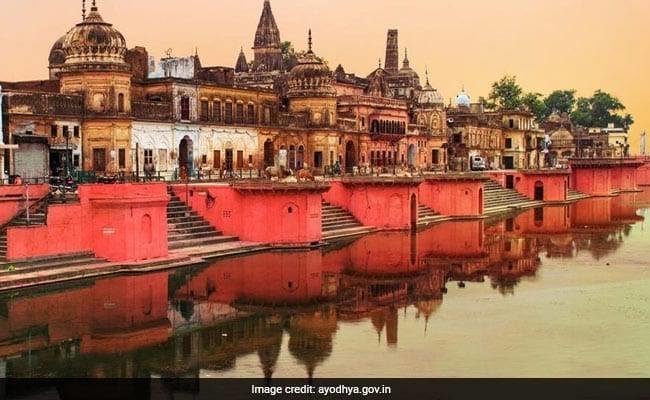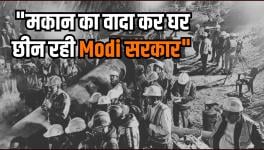Ayodhya Suffocates, But Nothing New About That

Saturday’s Supreme Court decision paves the way for construction of a temple dedicated to the Hindu god Rama at the disputed site in Ayodhya, but there were no celebrations in the city, nor was there a festive atmosphere. The reason is deployment of heavy security forces across the area—because of that, people stayed inside their houses.
Heavy security forces have been deployed in Ayodhya to control the post-verdict situation. The police, the Provincial Armed Constabulary, paramilitary security forces and the Rapid Action Force (RAF) have been deployed across the area. Even two-wheelers and motorcycles are not being allowed inside Ayodhya. Ramakot, a disputed and acquired site, is under strict security watch. The locals went for a few darshans and were allowed to, provided they showed their Aadhaar cards to those on duty. But the joy of the decision in favour of a Rama temple in Ayodhya was visible on the faces of the people.
Roads remained empty, there were no processions, sloganeering or fireworks; at least there was no fierce display of any kind on the streets. The moment people tried to celebrate, the police reached and refused to allow them to go on. The district officer held a meeting with the media before the verdict and urged people to “neither celebrate nor express sorrow.” They were not even allowed to show photographs of 6 December, which could be distressing. District Magistrate Anuj Kumar Jha and SSP Ashish Tiwari also conducted an aerial survey of the area in the afternoon.
After the Supreme Court’s decision, the people of Ayodhya-Faizabad breathed a sigh of relief. So much so that they had no idea what to do: Shops in Ayodhya remained closed all morning. After the decision, a few shops opened, slowly, but those near the Raj Sadan remained shut. At shops that did open, no shoppers showed up. The perambulation near Tulsi Udyan and the stalls set up for the Kartik Purnima fair remained in place as usual, but devotees from outside Ayodhya were told to return to their homes. So the stalls remained silent.
Even darshan at the temporary Ramlala temple or in the Ramakot area was on the basis of an Aadhaar card. All devotees from out of town were driven out of Ayodhya. It was circulated the previous night that people from outside should leave.
Media groups were desperate to meet Iqbal Ansari, one of the parties to the Babri dispute, and reached his house. Ansari only said that he is happy that the matter is finally resolved after so many years. “Our father had filed the title suit. Now we will not take any further steps, and will do whatever the government wants. We fully accept the decisions of the Supreme Court,” he said. While the claim of the Nirmohi Akhara was also rejected by the court, Ansari said that he is “happy that Ramlala will be seated at the site and a grand temple will be constructed at that place soon”.
The chief priest of Tiwari temple and Bharatiya Janata Party (BJP) leader Girishpati Tripathi says, “This is the best decision, to maintain harmony in the country and the world.” The Supreme Court has taken care of both sides, he felt.
In Faizabad city, Babloo, who runs a hotel in Ayodhya, is relieved by the decision. The constant closures in Ayodhya will be over, he felt. People will be able to come visit fearlessly. “You will not have to pass through police check points,” he says. So far, foreign travelers arriving in the city have to go to the police station and inform them. “Now anyone can easily come to Ayodhya and stay,” he hopes.
Those who live and trade on the road leading to Ramkot or Ramjanmabhoomi are the happiest. They expect to be freed from the restrictions and their business to increase. Mahant Ramsharan Das of the Rangmahal Temple adjacent to the disputed campus says, “Not only our Ramlala, but we ourselves are under the grips of security. Our temple is adjacent to the disputed site and we have trouble coming and going out of it.”
If anybody fell sick, or had to bring in grain or straw to the temple, there was much to-do. Kanhaiyadas, who is associated with the BJP, says that the development of Ayodhya was stalled by the dispute. “Now that the decision has come, Ayodhya will be developed and the business of the people will also increase.”
Dinesh Patwa, who owns a store at Hanumangarhi, is most pleased with the decision. He looks forward most to relief from the step-by-step inspections that used to take place of the goods traveling back and forth between the city’s businesses and traders. “Now we will be able to bring goods to our shop easily and shop freely too,” he says.
Kothaparcha, Kasaab Bada and other densely populated areas of Ayodhya are subject to strict searches. In Faizabad, the shops of some Hindus remained closed while the shops of some Muslims remained open.
Mahant Rajkumar Das, an officer of Ramvallabha Kunj, who is also close to the BJP, says he was happy that the Supreme Court has cleared the way for the construction of a temple, and also asked for 5 acres land to be given to the Muslims to build a mosque.
Ramprasad, who came to give offerings at Hanumangarhi, says that it is not necessary to express happiness over the verdict with excitement. It is perhaps the Vishwa Hindu Parishad spokesperson, Sharad Sharma, who sums up the verdict and the general mood around it: “The court,” he says, “Has stamped our view on the temple.”
Suman Gupta is a journalist in Ayodhya. The views are personal.
Get the latest reports & analysis with people's perspective on Protests, movements & deep analytical videos, discussions of the current affairs in your Telegram app. Subscribe to NewsClick's Telegram channel & get Real-Time updates on stories, as they get published on our website.














